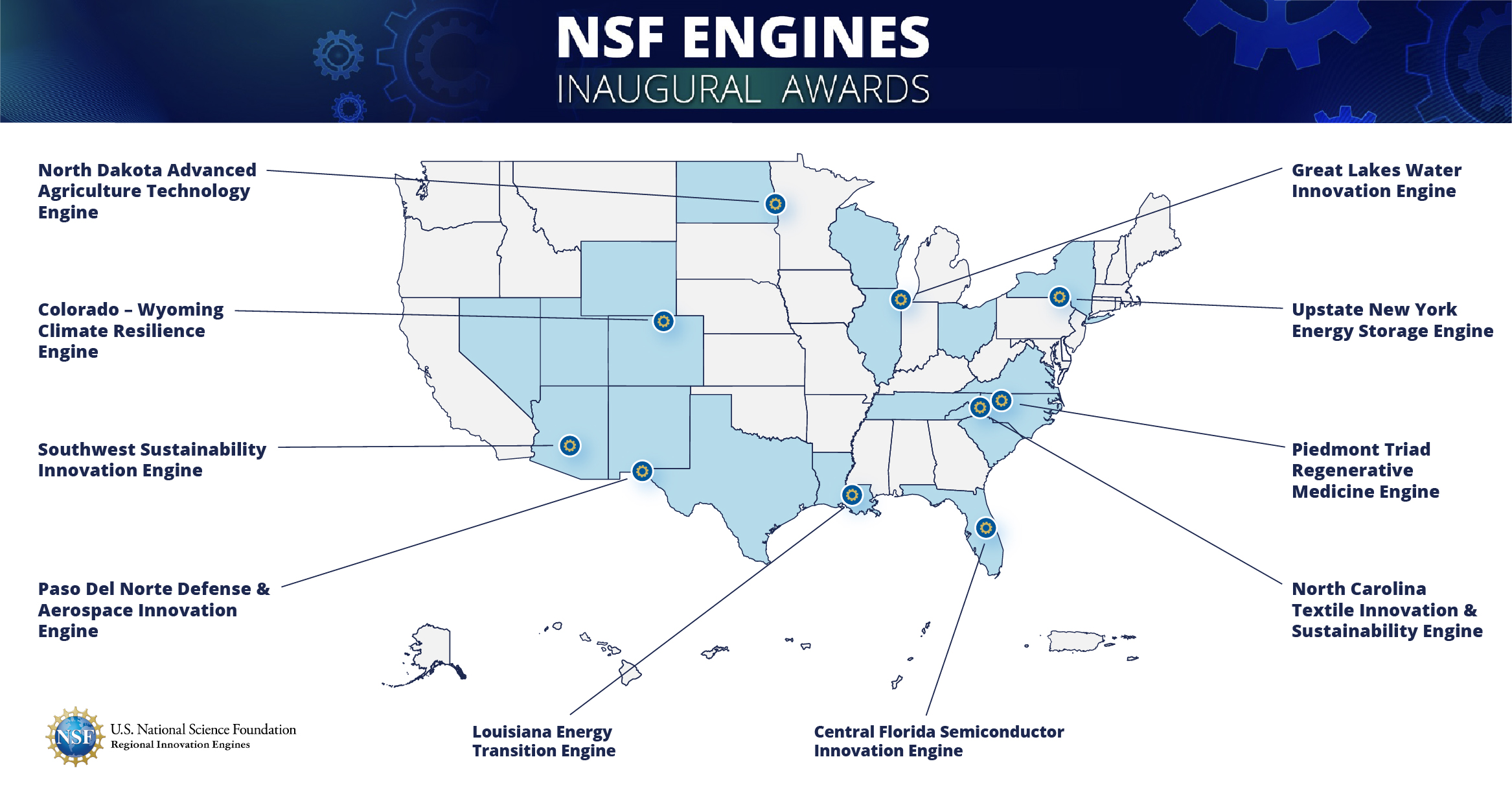Gears Mesh Across Newly Designated NSF Engine Locations
The Innovation Quarter in Winston-Salem is central to the focus of the Piedmont Triad Regenerative Medicine Engine.
Photo of Bailey Park in Winston Salem courtesy of Wake Forest University
On Monday, 20 months after the program’s creation, the U.S. National Science Foundation named 10 teams spanning 18 states as the first cohort in the NSF Regional Innovation Engines place-based R&D program authorized by the CHIPS and Science Act of 2022.
“Each NSF Engine will initially receive up to $15 million for two years,” the organization stated. “NSF’s initial $150 million investment in these 10 regions is being matched nearly two to one in commitments from state and local governments, other federal agencies, philanthropy and private industry. Teams that demonstrate progress toward well-defined milestones could potentially receive up to $160 million each from NSF over 10 years, as they seek to catalyze the NSF funding to draw additional investments into the overall region.”

Map courtesy of NSF
Last May the NSF also designated 44 NSF Engines Development awardees, which each received $1 million to further develop their partnerships and model for a future NSF Engines proposal. The announcement this week invited 15 more coalitions to pursue that level of award. That means 69 coalitions in all are now officially part of the program, picked from nearly 700 regional innovation concepts that applied for awards.
Click on the following links to access detailed descriptions of each NSF Engine’s focus and partners:
- Central Florida Semiconductor Innovation Engine
- Colorado – Wyoming Climate Resilience Engine
- Great Lakes Water Innovation Engine
- Louisiana Energy Transition Engine
- North Carolina Textile Innovation and Sustainability Engine
- North Dakota Advanced Agriculture Technology Engine
- Paso del Norte Defense and Aerospace Innovation Engine
- Piedmont Triad Regenerative Medicine Engine
- Southwest Sustainability Innovation Engine
- Upstate New York Energy Storage Engine
The 10 designees are well spaced across the nation with one prominent exception: Two are led by organizations in close proximity in North Carolina. Add in the layer of additional Development Engine locations and clusters begin to appear in the Southeast, Upper Midwest and Northeast.

Map courtesy of NSF
The Piedmont Triad Regenerative Medicine Engine, based in Winston-Salem, aims to “tap the world’s largest regenerative medicine cluster to create and scale breakthrough clinical therapies, contributing to an ever-growing industry that is key to healthcare delivery,” said a release from Wake Forest University. Led by Wake Forest Institute for Regenerative Medicine (WFIRM), the team includes Forsyth Technical Community College (FTCC), North Carolina Agricultural and Technical State University (N.C. A&T), the RegenMed Development Organization (ReMDO), and Winston Salem State University (WSSU).
The North Carolina Sustainable Textile Innovation and Sustainability Engine, based in Raleigh and Gaston, is led by Morganton-based nonprofit The Industrial Commons (TIC) and includes locations in both Carolinas, Tennessee and Virginia.
“Although this industry has seen its fair share of challenges, we see so much potential for it to drive economic change in our region,” said TIC Co-Executive Director Molly Hemstreet. “This award will allow us to build on our legacy industries and depth of innovation to create opportunity for workers and our communities.”
In addition to core partners North Carolina State University, Wilson College of Textiles, the Manufacturing Solutions Center at Catawba Valley Community College, Gaston Textile Technology Center at Gaston Community College and Western Piedmont Community College, the coalition’s leadership team also includes the North Carolina Department of Commerce Office of Science Technology and Innovation, NC Idea and the Research Triangle Institute.
A ceremony that included First Lady Jill Biden took place at Forsyth Technical Community College this week to celebrate the NSF’s two Engines designations in the state. “This groundbreaking investment in place-based science and technology research and development will spur economic growth and catalyze breakthrough technologies in regenerative medicine and textile manufacturing,” said NSF Director Sethuraman Panchanathan. “This will no doubt generate regional job growth and economic development in the regions served by these two NSF Engines delivering on NSF’s priority to create opportunities everywhere and innovations anywhere across the nation.” — Adam Bruns

